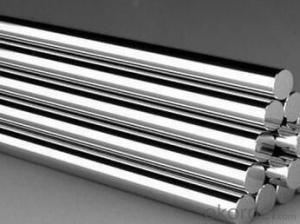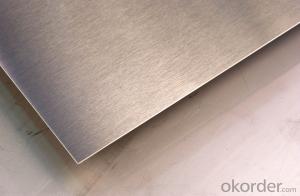Stainless Steel Sheet and Stainless Steel Pipe Price Per Kg
- Loading Port:
- Shanghai
- Payment Terms:
- TT OR LC
- Min Order Qty:
- 1 m.t.
- Supply Capability:
- 20000 m.t./month
OKorder Service Pledge
OKorder Financial Service
You Might Also Like
Item specifice
Stainless Steel Sheet and Stainless Steel Pipe Price Per Kg
Packaging Details:Wooden pallets,water proof paper-20'GP or 40'GP for stainless steel sheet.
Delivery Detail:within 5-7 days after receiving the deposit
1. Specifications about stainless steel sheet
Commodity | Professional 430 201 202 304 304l 316 316l 321 310s 309s 904l stainless steel sheet |
Grade | 201,202,304,304L,316,316L,310S,309S,321,301,310,410,420,430,904L |
Brand | TISCO ,BAOSTEEL,POSCO,JISCO,LISCO |
Certification | SGS,BV,IQI,TUV,ISO,etc |
Thickness | 0.2mm-150mm |
Width | 1000,1219,1250,1500mm, or as your requirements |
Length | 2000,2438,2500,3000,6000mm, or as your requirements |
Surface | No.1, 2B, BA, 8K Mirror, Hairline,satin, Embossed,brush,No.4,HL,matt,pvc film,laser film. |
Standard | ASTM,AISI,SUS,JIS,EN,DIN,GB, ASME,etc |
Delivery time | 5-7 days after confirming the order |
MOQ | 1 Ton |
Advantages | Showing the splendor of your quality, wearresistant as well , strong corrosion resistance and decorative effect, durable and beautiful in good taste. |
2.Production Flow about stainless steel sheet
Raw materials are sending to hot rolling units for rolling into different sizes
Hot rolled material is annealing in cold; rolled annealing furnace and pickling in acid.
All mill rolls are grinded on precision grinding machine with proper chamfering after first shiftoperation.
All sheets are pickled in different tanks and dried on brush roll machine before dispatched.
These sheets are again annealing and are sent to straighten machine for straightening.
Inspections are done at various stages. Keep proper control overall internal process via rolling,annealin and pickling by our experienced staff.
3.Surface--stainless steel sheet
| Surface Finish | Definition | Application |
| 2B | Those finished, after cold rolling, by heat treatment, pickling or other equivalent treatment and lastly by cold rolling to given appropriate luster. | Medical equipment, Food industry, Construction material, Kitchen utensils. |
BA/8K mirror | Those processed with bright heat treatment after cold rolling. | Kitchen utensils, Electric equipment, Building construction. |
| NO.3 | Those finished by polishing with No.100 to No.120 abrasives specified in JIS R6001. | Kitchen utensils, Building construction. |
| NO.4 | Those finished by polishing with No.150 to No.180 abrasives specified in JIS R6001. | Kitchen utensils, Building construction, Medical equipment. |
| Hairline | Those finished polishing so as to give continuous polishing streaks by using abrasive of suitable grain size. | Building Construction. |
| NO.1 | The surface finished by heat treatment and pickling or processes corresponding there to after hot rolling. | Chemical tank, pipe. |
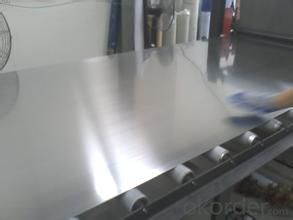
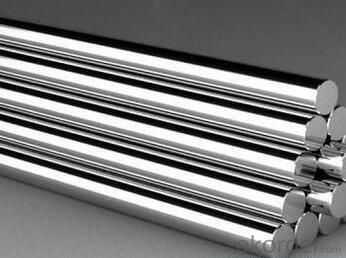
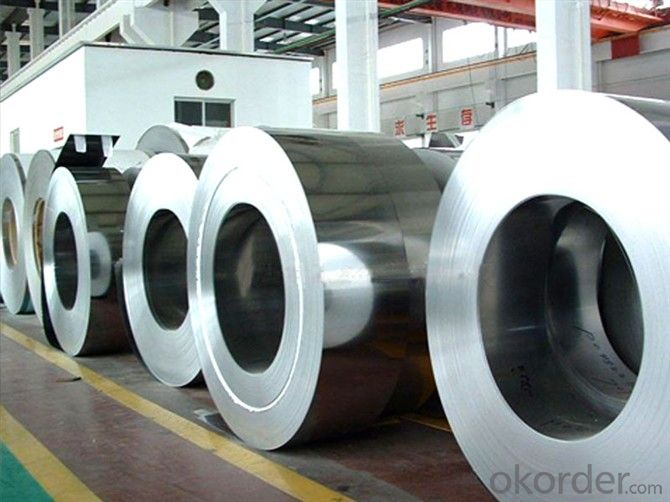
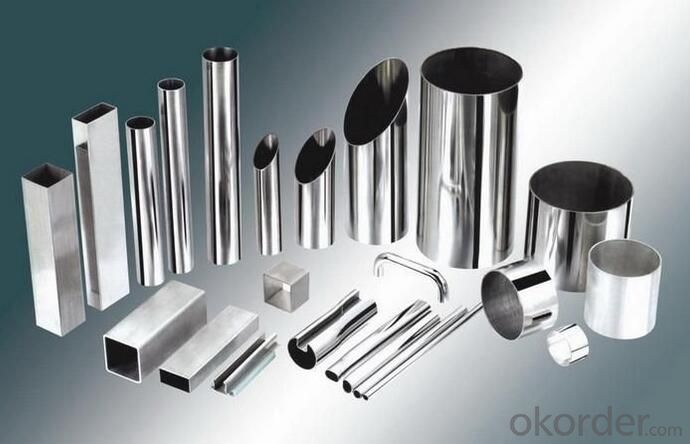
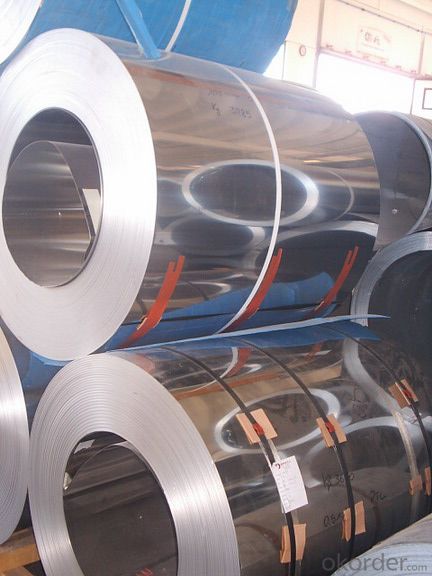
- Q:How do you determine the weight of a stainless steel sheet?
- To determine the weight of a stainless steel sheet, one must take into account its dimensions, thickness, and density. The first step involves using a measuring tool, such as a ruler or caliper, to measure the length, width, and thickness of the sheet. It is crucial to ensure that all measurements are taken in the same unit of measurement, such as inches or millimeters, for accuracy. Next, the density of stainless steel needs to be determined. Typically, stainless steel has a density of approximately 7.9 grams per cubic centimeter (g/cm³) or 7900 kilograms per cubic meter (kg/m³). However, it is important to note that this value may slightly vary depending on the specific grade or alloy of stainless steel being used. Once the dimensions and density are known, the weight can be calculated using the formula: weight = volume × density. To find the volume, one should multiply the length, width, and thickness of the sheet. For instance, if a stainless steel sheet measures 1 meter by 1 meter and has a thickness of 2 millimeters, the volume would be 0.001 cubic meters (1m x 1m x 0.002m). By utilizing the density of stainless steel (7900 kg/m³), one can then determine the weight by multiplying the volume by the density. In the given example, the weight of the stainless steel sheet would amount to 7.9 kilograms (0.001m³ x 7900 kg/m³). It is essential to bear in mind that this calculation provides an approximate weight, assuming a consistent thickness throughout the entire sheet. Furthermore, variations in composition or manufacturing processes may result in slight deviations in the density of the stainless steel, thereby affecting the accuracy of the weight calculation.
- Q:How do you remove fingerprints from brushed stainless steel sheets?
- These simple steps can be followed to remove fingerprints from brushed stainless steel sheets: 1. Gather the necessary cleaning supplies, including a microfiber cloth, mild dish soap, warm water, and either a stainless steel cleaner or vinegar. 2. Dampen the microfiber cloth with warm water, ensuring that it is slightly damp but not soaking wet. 3. Carefully wipe the stainless steel surface in the direction of the grain, always following the grain to prevent scratches or streaks. 4. If the fingerprints persist, add a small amount of mild dish soap to the damp cloth and continue wiping the surface. Rinse the cloth thoroughly after applying the soap. 5. If the fingerprints are still visible, utilize a stainless steel cleaner specifically designed for brushed surfaces. Apply a small amount of the cleaner onto the microfiber cloth and wipe the surface in the direction of the grain. Adhere to the manufacturer's instructions for the particular cleaner being used. 6. As an alternative, employ white vinegar as a natural cleaning solution. Dampen a cloth with vinegar and gently wipe the surface in the direction of the grain. Vinegar is effective in removing fingerprints and restoring shine. 7. After successfully removing the fingerprints, use a dry microfiber cloth to gently buff the surface. This will eliminate any remaining streaks and provide the stainless steel with a polished finish. Always test any cleaning solution on a small, inconspicuous area of the stainless steel sheet before applying it to the entire surface. Avoid using abrasive materials or cleaners containing chlorine or bleach, as they can harm the brushed finish of the stainless steel.
- Q:Can stainless steel sheets be used for roofing or cladding?
- Yes, stainless steel sheets can be used for roofing or cladding. Stainless steel is a durable and corrosion-resistant material that is well-suited for exterior applications. It offers excellent strength and can withstand harsh weather conditions, making it an ideal choice for roofing or cladding. Additionally, stainless steel has a sleek and modern appearance, which can enhance the aesthetic appeal of a building. Its longevity and low maintenance requirements also make it a cost-effective option in the long run. Overall, stainless steel sheets are a reliable and versatile choice for roofing or cladding projects.
- Q:What is the abrasion resistance of stainless steel sheets?
- Stainless steel sheets are widely acknowledged for their high level of abrasion resistance. They possess exceptional durability and hardness, which render them impervious to damage caused by friction or contact with abrasive substances. The extent of this abrasion resistance can differ, depending on factors such as the grade and finish of the stainless steel sheet, as well as the particular purpose it serves. Nonetheless, stainless steel sheets are renowned for their outstanding ability to withstand scratches, scuffs, and other types of abrasion, thereby making them a preferred option across diverse industries that prioritize longevity and durability.
- Q:How do you calculate the cost of a stainless steel sheet?
- To calculate the cost of a stainless steel sheet, there are a few factors that need to be considered. 1. Determine the dimensions: The first step is to know the length, width, and thickness of the stainless steel sheet. These measurements will determine the amount of material needed, which is a significant factor in calculating the cost. 2. Determine the grade: Stainless steel sheets come in various grades, such as 304, 316, or 430. Each grade has different properties and costs associated with it. The grade required for a specific application will influence the price of the sheet. 3. Determine the finish: Stainless steel sheets can have different finishes, including brushed, polished, or patterned. The finish required will impact the cost as each finish requires different processes and materials. 4. Consider quantity: The quantity of stainless steel sheets needed can also affect the cost. Bulk orders often come at a discounted price, whereas smaller quantities may be subject to higher prices. 5. Research suppliers: It is crucial to research different suppliers and compare prices. Prices can vary depending on the supplier's location, reputation, and market conditions. 6. Additional costs: Some additional costs may be involved, such as transportation, handling, or cutting fees. It is important to inquire about these costs when obtaining quotes from suppliers. By considering these factors and doing thorough research, one can accurately calculate the cost of a stainless steel sheet.
- Q:How do I bend or form stainless steel sheets?
- To bend or form stainless steel sheets, you can follow these steps: 1. Choose the appropriate stainless steel grade: Stainless steel comes in various grades, each with specific properties. Select the grade that best suits your project's requirements, considering factors like corrosion resistance, strength, and formability. 2. Use the right tools: To bend stainless steel sheets, you will need specific tools such as a hydraulic press brake or a metal bending machine. These tools apply force evenly to achieve precise and consistent bends. Make sure to use tools that are designed for stainless steel to avoid damaging the material. 3. Prepare the stainless steel sheet: Before bending, ensure that the stainless steel sheet is clean and free from any dirt or debris. Additionally, mark the desired bending lines on the sheet using a pencil or tape to guide you during the process. 4. Determine the bending angle and radius: Determine the angle and radius of the bend you want to achieve. This will depend on the specific requirements of your project. Use a protractor or a template to measure and mark the desired angles accurately. 5. Secure the stainless steel sheet: To prevent movement or slipping during the bending process, securely clamp the stainless steel sheet to the bending tool or machine. This will ensure stability and accuracy during the bending process. 6. Apply pressure gradually: Start the bending process slowly and gradually increase the pressure. This prevents the stainless steel sheet from cracking or warping. Monitor the bending carefully to ensure that the desired shape is achieved without any defects or deformation. 7. Repeat if necessary: If you need to create multiple bends or complex shapes, repeat the process as required. Ensure that each bend is carefully measured and aligned with the previous bends to achieve a consistent and accurate result. 8. Finishing touches: After bending the stainless steel sheet, remove any residual marks or burrs using a file or sandpaper. This will give your finished product a smooth and polished appearance. Remember, bending stainless steel sheets can be challenging, especially for thicker gauges or harder grades. It is advisable to practice on scrap pieces or seek professional assistance if you are unsure or lack experience in working with stainless steel.
- Q:Can stainless steel sheets be used for roofing applications?
- Yes, stainless steel sheets can be used for roofing applications. Stainless steel is a durable and corrosion-resistant material, making it suitable for outdoor use and protecting against weather elements. It offers excellent strength and longevity, making it a popular choice for roofing in both commercial and residential settings.
- Q:Can stainless steel sheets be used for brewery piping?
- Yes, stainless steel sheets can be used for brewery piping. Stainless steel is a common material choice for brewery piping due to its corrosion resistance, durability, and hygienic properties. It can withstand the harsh conditions and high temperatures associated with the brewing process, making it an ideal material for brewery piping systems.
- Q:Are stainless steel sheets suitable for water tanks?
- Yes, stainless steel sheets are suitable for water tanks. Stainless steel is highly resistant to corrosion, making it ideal for storing water. It does not react with the water or contaminate it with any harmful substances. Stainless steel tanks are durable, long-lasting, and low maintenance. They can withstand high temperatures and extreme weather conditions without compromising their structural integrity. Furthermore, stainless steel is non-porous and does not provide a breeding ground for bacteria or algae growth. These qualities make stainless steel sheets an excellent choice for water tanks in various applications, including residential, commercial, and industrial settings.
- Q:Are stainless steel sheets suitable for water treatment applications?
- Water treatment applications can greatly benefit from the use of stainless steel sheets. The reason for this is that stainless steel has exceptional resistance to corrosion, making it the perfect material for environments where there is a presence of water and moisture. It is able to withstand rust, staining, and pitting, guaranteeing the sheets' longevity and durability in water treatment facilities. Moreover, stainless steel sheets possess hygienic qualities. They are effortless to clean and maintain, which is especially crucial in water treatment applications where cleanliness and sanitation are of the utmost importance. Additionally, stainless steel does not react with water, meaning it does not release harmful substances into the water being treated. In addition to these benefits, stainless steel sheets exhibit strength and can tolerate high pressures and temperatures. This is highly significant in water treatment processes that involve filtration, disinfection, and other treatment methods that may require rigorous conditions. To conclude, stainless steel sheets are an outstanding option for water treatment applications due to their resistance to corrosion, hygienic properties, strength, and durability. They present a dependable and long-lasting solution for various components in water treatment facilities, including tanks, pipes, valves, and other equipment.
1. Manufacturer Overview |
|
|---|---|
| Location | |
| Year Established | |
| Annual Output Value | |
| Main Markets | |
| Company Certifications | |
2. Manufacturer Certificates |
|
|---|---|
| a) Certification Name | |
| Range | |
| Reference | |
| Validity Period | |
3. Manufacturer Capability |
|
|---|---|
| a)Trade Capacity | |
| Nearest Port | |
| Export Percentage | |
| No.of Employees in Trade Department | |
| Language Spoken: | |
| b)Factory Information | |
| Factory Size: | |
| No. of Production Lines | |
| Contract Manufacturing | |
| Product Price Range | |
Send your message to us
Stainless Steel Sheet and Stainless Steel Pipe Price Per Kg
- Loading Port:
- Shanghai
- Payment Terms:
- TT OR LC
- Min Order Qty:
- 1 m.t.
- Supply Capability:
- 20000 m.t./month
OKorder Service Pledge
OKorder Financial Service
Similar products
New products
Hot products
Hot Searches
Related keywords

